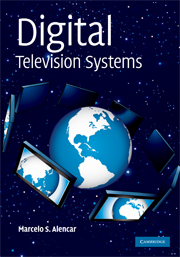Book contents
- Frontmatter
- Contents
- List of figures
- List of tables
- List of contributors
- Preface
- Acknowledgments
- 1 Fundamentals of digital television
- 2 Audio and video coding
- 3 Fundamentals and standards of video and audio compression
- 4 Channel coding for digital television
- 5 Digital and analog transmission systems
- 6 Advanced Television Systems Committee standard (ATSC)
- 7 Digital video broadcasting (DVB)
- 8 International Services Digital Broadcasting for Terrestrial Television Broadcasting (ISDB)
- 9 International System for Digital Television (ISDTV)
- 10 Digital terrestrial television multimedia broadcasting (DTMB)
- Appendix A Evolution of television standards
- Appendix B Signal analysis
- Appendix C Random signals and noise
- Glossary
- References
- Index
9 - International System for Digital Television (ISDTV)
Published online by Cambridge University Press: 28 January 2010
- Frontmatter
- Contents
- List of figures
- List of tables
- List of contributors
- Preface
- Acknowledgments
- 1 Fundamentals of digital television
- 2 Audio and video coding
- 3 Fundamentals and standards of video and audio compression
- 4 Channel coding for digital television
- 5 Digital and analog transmission systems
- 6 Advanced Television Systems Committee standard (ATSC)
- 7 Digital video broadcasting (DVB)
- 8 International Services Digital Broadcasting for Terrestrial Television Broadcasting (ISDB)
- 9 International System for Digital Television (ISDTV)
- 10 Digital terrestrial television multimedia broadcasting (DTMB)
- Appendix A Evolution of television standards
- Appendix B Signal analysis
- Appendix C Random signals and noise
- Glossary
- References
- Index
Summary
Introduction
Television is one of the most popular communication media in Brazil, where over 94.6% of households have at least one television set. This corresponds to more than 80 million television sets. Besides providing free access to entertainment and culture, broadcast television acts as an unifying factor of fundamental importance to a country of the size of Brazil.
After 50 years of existence, Brazilian television is undergoing significant changes with the arrival of the digital television (DTV) technology. DTV not only represents progress in terms of communications technology, but also a new concept in terms of accessing media information. Within the same bandwidth currently used by analog television channels, DTV is able to transmit different types of programs that may include high-definition television (HDTV) programs, several standard-definition television (SDTV) programs, several audio programs or even several multimedia (lower-definition) programs. One of the major novelties of DTV is the advent of interactivity between users and broadcasters/content providers. With DTV, users are able to participate in polls, play games, surf the Web and send and receive emails. In summary, besides providing a better quality of image and sound, and a large variety of services, the technology of DTV transmission allows better utilization of the spectrum, which translates into more channels in the same geographic area.
Effective action to implement DTV in Brazil started in the late 1990s with the work of the Brazilian Commission of Communications, a body of the National Telecommunications Agency (Anatel).
- Type
- Chapter
- Information
- Digital Television Systems , pp. 178 - 201Publisher: Cambridge University PressPrint publication year: 2009



